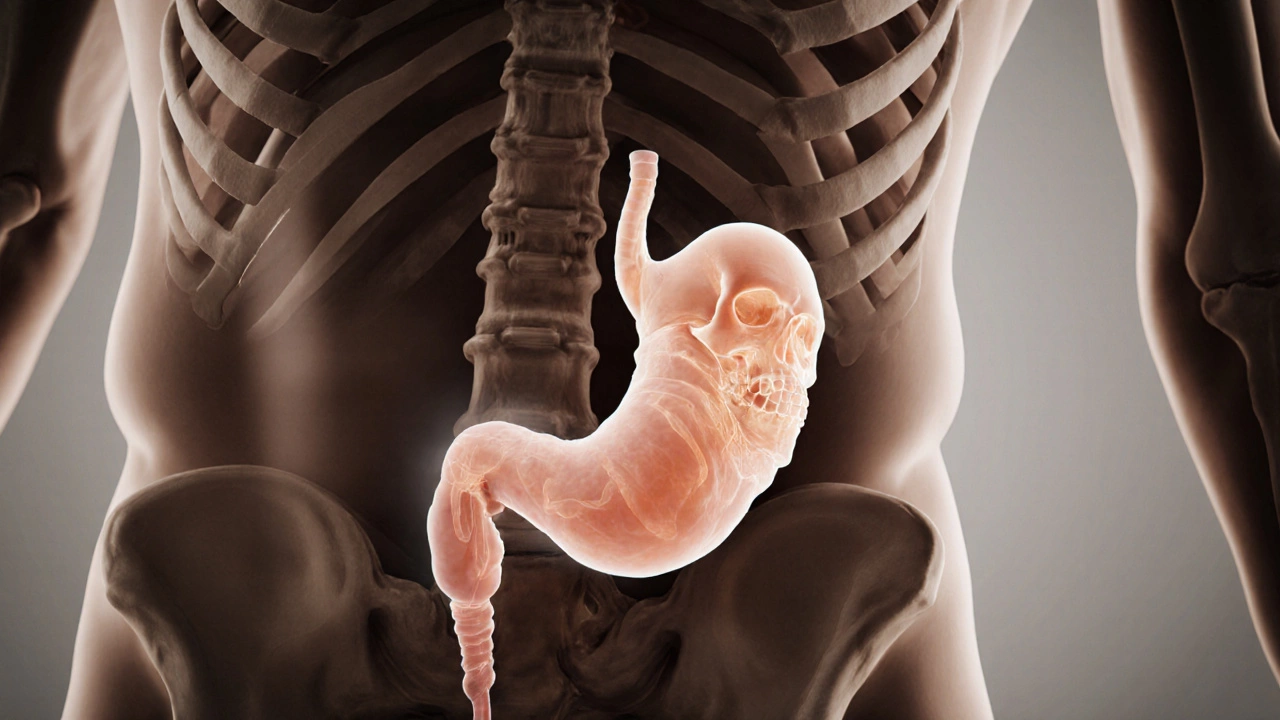Silent Killer Cancer Risk Assessment
Answer the following questions to get an assessment of your risk for developing silent killer cancers.
Risk Factors Identified:
Recommendations:
Common Silent Killer Symptoms
- Unexplained weight loss
- New-onset diabetes
- Persistent abdominal/back pain
- Changes in stool
- Sudden bloating
Key Risk Factors
- Smoking increases risk by 2-3x
- Obesity linked to multiple cancers
- Family history can raise odds 5-10x
- Chronic alcohol use elevates risk
- Long-standing diabetes promotes tumor growth
Key Takeaways
- silent killer cancer most often refers to pancreatic cancer because it shows few early signs.
- Common silent killers also include ovarian, liver and lung cancers, each with subtle early clues.
- Early detection relies on risk‑factor awareness, biomarker tests like CA 19‑9, and imaging such as CT or MRI.
- Lifestyle changes-quitting smoking, maintaining a healthy weight, limiting alcohol-can lower the odds.
- When caught early, surgical removal, targeted therapy, and clinical trials dramatically improve survival.
What Does "Silent Killer" Really Mean?
When doctors call a disease a "silent killer," they mean it can progress for months or years without obvious symptoms. By the time the problem becomes noticeable, the disease has often reached an advanced stage. This makes early diagnosis harder and mortality rates higher.
Pancreatic Cancer - The Classic Silent Killer
Pancreatic cancer is a malignant growth that originates in the pancreas, an organ tucked behind the stomach that produces digestive enzymes and insulin. Because the pancreas sits deep in the abdomen, tiny tumors rarely cause pain or visible changes, earning it the nickname "silent killer." According to the World Health Organization, pancreatic cancer accounts for about 3% of all cancers but is the fourth leading cause of cancer death worldwide.
Why does it stay hidden?
- Early tumors are small and don’t press on nerves or organs.
- Symptoms such as mild back pain or slight fatigue are easily dismissed.
- There is no widely recommended population‑wide screening test.

Other Cancers Frequently Tagged as Silent Killers
While pancreatic cancer tops the list, a few other cancers share the "silent" trait.
- Ovarian cancer often grows inside the pelvic cavity, causing vague abdominal bloating that many attribute to digestion.
- Liver cancer can develop without jaundice or pain until the liver is significantly compromised.
- Lung cancer especially the small‑cell type, may not produce a cough until the tumor obstructs airways.
Recognizing the Subtle Signs
Because the early clues are mild, it helps to know the red‑flag patterns.
- Unexplained weight loss of more than 5% over a few weeks. \n
- New‑onset diabetes or worsening blood‑sugar control (often seen with pancreatic tumors).
- Persistent back or upper‑abdominal pain that doesn't improve with usual remedies.
- Changes in stool - pale, oily, or foul‑smelling (a sign of pancreatic enzyme blockage).
- Sudden bloating, feeling of fullness after eating small meals.
If any of these persist for more than a month, it’s worth talking to a doctor, especially if you have known risk factors.
Key Risk Factors You Can Influence
| Risk Factor | Associated Cancer(s) | Impact |
|---|---|---|
| Smoking | Pancreatic, Lung, Liver | Increases risk by 2‑3× |
| Chronic heavy alcohol use | Pancreatic, Liver | Elevates risk of pancreatitis, a precursor to cancer |
| Obesity (BMI≥30) | Pancreatic, Liver, Ovarian | Linked to insulin resistance and hormonal changes |
| Family history of pancreatic or ovarian cancer | Pancreatic, Ovarian | Genetic mutations (BRCA2, CDKN2A) raise odds 5‑10× |
| Diabetes lasting >5years | Pancreatic | Long‑standing hyperglycemia can promote tumor growth |

How Doctors Spot These Hidden Tumors
Because symptoms are vague, doctors lean on a mix of blood tests and imaging.
- Biomarker CA 19‑9: CA 19‑9 is a carbohydrate antigen that often rises in pancreatic cancer patients. Levels above 200U/mL may prompt further scans, though inflammation can also elevate the marker.
- Computed Tomography (CT) Scan: CT scan provides cross‑sectional images that reveal small masses in the pancreas, liver or lungs. Modern multi‑detector CT can detect tumors as small as 5mm.
- Magnetic Resonance Imaging (MRI): MRI offers excellent soft‑tissue contrast, useful for spotting lesions in the liver and pancreas. MRI with contrast (MRCP) visualizes the pancreatic duct system.
- Endoscopic Ultrasound (EUS): A tiny ultrasound probe on a flexible endoscope gets close to the pancreas, allowing doctors to biopsy suspicious spots.
When a suspicious area is found, a tissue sample (biopsy) confirms whether cancer cells are present.
Treatment Paths Once Cancer Is Detected
Early‑stage pancreatic cancer (StageI‑II) can often be treated with curative intent.
- Surgery: The Whipple procedure (pancreaticoduodenectomy) removes the head of the pancreas and surrounding tissue. Surgeons now achieve postoperative survival rates of 30‑40% at five years when the tumor is small.
- Chemotherapy: Regimens like FOLFIRINOX or gemcitabine plus nab‑paclitaxel shrink tumors and improve outcomes.
- Radiation therapy: Used after surgery or with chemo to target residual disease.
- Targeted therapy & immunotherapy: For patients with specific genetic mutations (e.g., BRCA2), PARP inhibitors or checkpoint inhibitors may be options.
Advanced cases focus on extending life and quality of life, often through palliative chemo, pain control, and nutritional support.
Prevention - The Best Way to Outrun a Silent Killer
While you can’t change genetics, lifestyle tweaks make a huge difference.
- Stop smoking - even occasional use raises risk.
- Limit alcohol to ≤1 drink per day for women, ≤2 for men.
- Maintain a BMI between 18.5‑24.9.
- Eat a diet rich in fruits, vegetables, whole grains, and lean protein.
- Exercise at least 150minutes of moderate activity each week.
- Get regular medical check‑ups, especially if you have a family history of pancreatic or ovarian cancer.
If you belong to a high‑risk group (family mutations, chronic pancreatitis), discuss screening programs with a gastroenterologist. Some centers offer annual MRI or EUS for early detection.
Frequently Asked Questions
Why is pancreatic cancer called the "silent killer"?
Because early tumors are hidden deep in the abdomen and cause no obvious pain or warning signs, most patients discover it only after it has spread.
Can a regular blood test detect pancreatic cancer?
The CA 19‑9 marker is helpful but not definitive; it can be high in benign conditions too. It is used alongside imaging, not as a stand‑alone screen.
What are the survival odds if pancreatic cancer is caught early?
For StageI disease, five‑year survival can exceed 30‑40% after successful surgery and adjuvant therapy, compared with under 10% for advanced stages.
Is there any screening program for people without symptoms?
General population screening isn’t recommended because of low prevalence and false‑positive rates. High‑risk individuals (family history, genetic mutations) may qualify for annual MRI or endoscopic ultrasound.
How does lifestyle affect the risk of silent cancers?
Smoking, heavy alcohol use, obesity, and a diet low in fiber all increase inflammation and hormone imbalances that can promote tumor growth. Changing these habits can lower risk by up to 40% for some cancers.
What symptoms should prompt a doctor visit if I have a family history of pancreatic cancer?
New‑onset diabetes, unexplained weight loss, persistent upper‑abdominal or back pain, and jaundice (yellow skin) are red flags that merit imaging studies.





